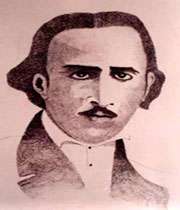Mohammad-Reza Mirzada Eshqi
part 3

Perhaps in an attempt to establish a forum for his own ideas, Eshqi decided not to publish his own newspaper. Qarn-e bistom, the weekly journal with which his name is most famously associated, first appeared on 27 Shaban 1339/5 May 1921 (Sadr Hashemi, Jaraed o majallat IV, p. 105), but was suppressed after only four issues. It resumed publication over a year and a half later, on 28 Jomada I 1341/15 January 1923, this time in four pages, and distributed more widely than before. Because the paper lists Abbas Eskandari as its managing editor, ل¹¢adr Hashemi (IV, p. 106) speculates that in its second year, Qarn-e bistom may have taken the place of Siasat, a suppressed journal managed by Eskandari. The eighteenth issue of this second series was published on 28 لamal 1302 SH./17 April 1923). It was suppressed again until 7 Tir 1303 SH./29 June 1923, when a single issue was published. It is widely believed that this issue sealed Eshqi’s fate. In its eight pages, Eshqi had written, once more, against the republican movement, widely believed to have been plotted by Reza Khan and his supporters against the Constitution. Five days later, he was assassinated by two gunmen in his residence. He was buried the next day in Ebn-e Babuya cemetery, a ceremony which the Majles members of the minority party and other opponents of Prime Minister Reإ¼a Khan quickly turned into an occasion for public protest against the rising tide of his power.
Since his death, Eshqi’s life and career have been the subject of many romanticized accounts. The desire to pay homage to a martyred poet with nationalistic and patriotic views, and to celebrate the spirit of an uncompromising revolutionary may have underlain this tendency.
This has cast a shadow on Eshqi’s real historical significance as a modernist poet, and a source of inspiration to other poets, most notably to his younger contemporary, Nima Yushij. Eshqi’s unique contribution to the process of modernity in Persian poetry lies in his attempt to liberate Persian poetry from systemic constraints of the classical system of poetic signification. In such works as ”Nowruzi-nama,” Rastakhiz-e shahriaran, and above all in Se tablo, the first traces of a systemic change in Persian poetry becomes visible (Karimi-Hakkak, pp. 212-31). Eshqi’s vision of poetry as a focus for the expression of immediate and unadorned, as opposed to conventional and stylized, sensory perceptions imparts a sense of verisimilitude to his poems which may have struck his original readers as prosaic, but was later taken up by Nima Yushij and developed into an essential principle of modernist Persian poetry in Persia.
Bibliography (for cited works not given in detail see ”Short References”): Almost all of Eshqi’s writings, as well as much information on his life and ideas, have been gathered in a single work by Ali-Akbar Moshir Salimi, a friend of the poet. In successive editions of Kolliyat-e moل¹£awwar-e Mirzada Eshqi (8th ed., Tehran, 1357 SH./1978), the editor, Moshir Salimi, has brought together virtually all of ت؟Eshqi’s known poetic compositions, his most important political articles, and observations and memories of various individuals concerning Eshqi’s life, particularly accounts of circumstances surrounding his assassination. Still, these writings are vague on several points and inconsistent or contradictory on others.
Sources: wikis adn encyclopedias
Other Links:
Abul-Ghasem Payandeh (part 2)
Abul-Qasem Aref Qazvini (part 1)
Mohammad-Reza Mirzada Eshqi